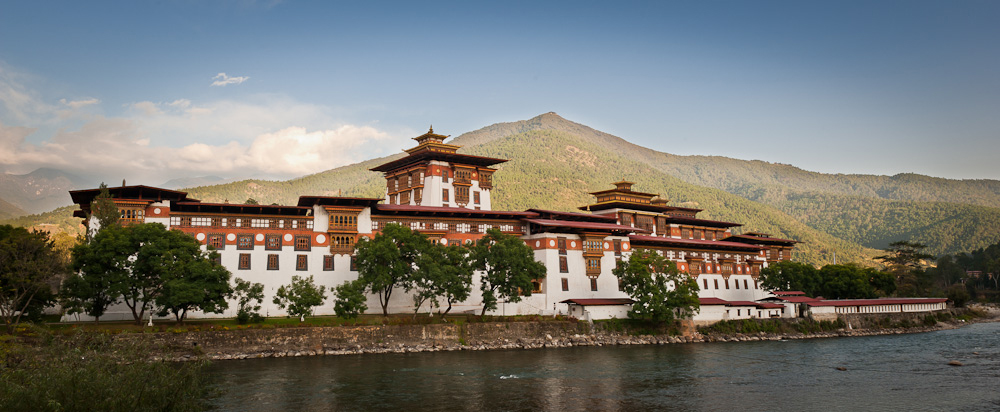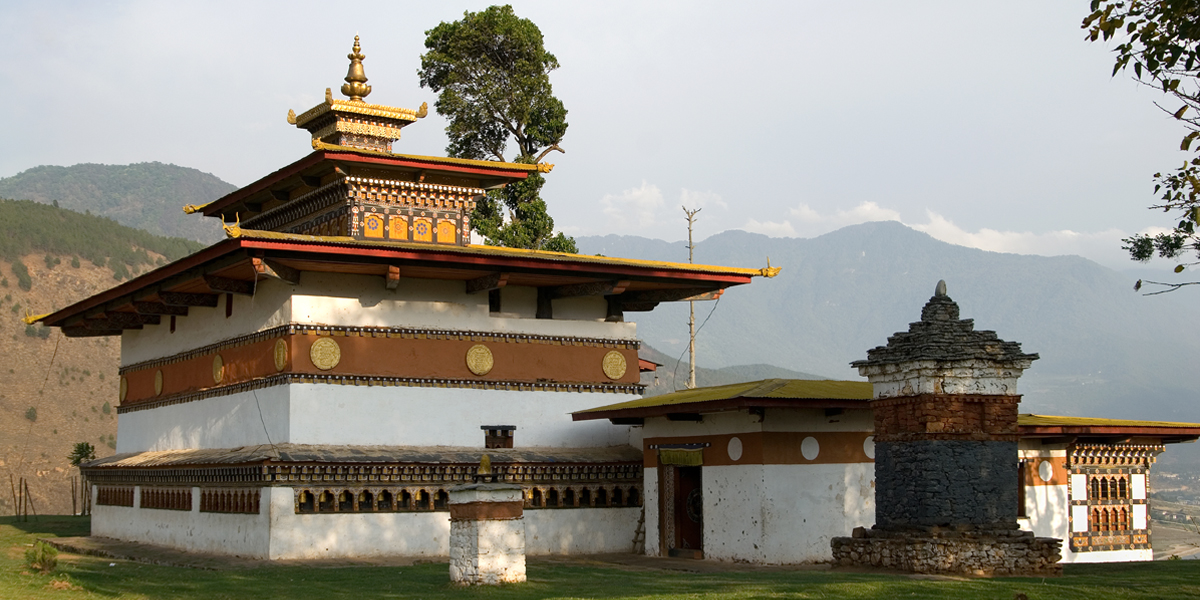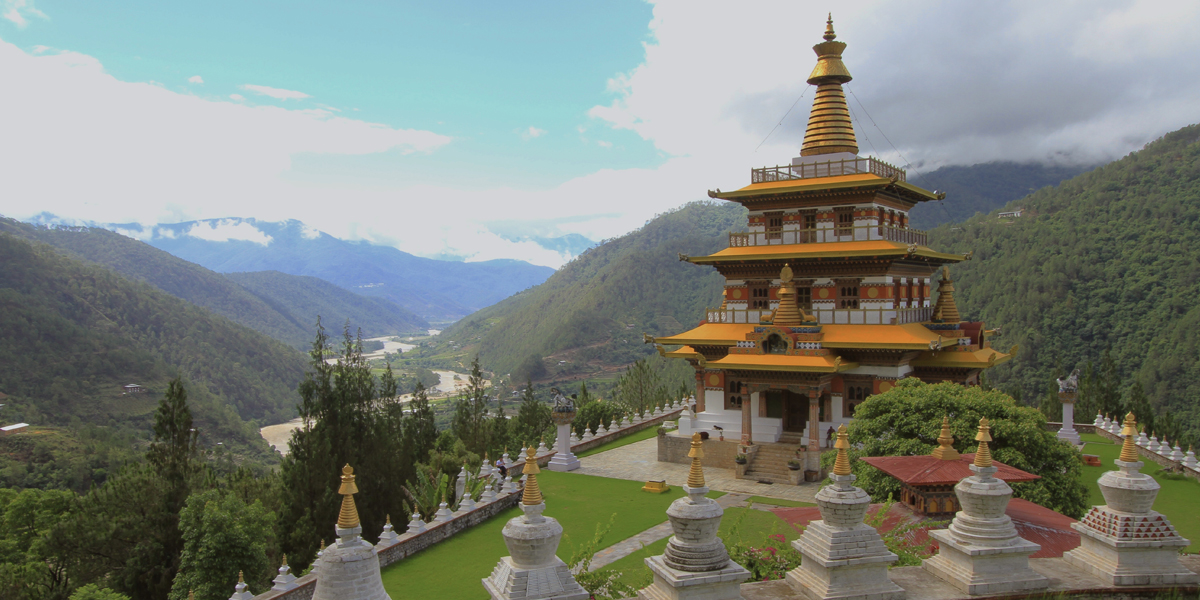Punakha (1,310m / 4,300ft )
Punakha, the ancient capital of Bhutan, is a picturesque valley town located at the confluence of the Pho Chhu and Mo Chhu rivers. Known for its subtropical climate and fertile valleys, Punakha is famed for the majestic Punakha Dzong, a stunning fortress that serves as a significant religious and administrative center. Surrounded by terraced rice fields and lush hills, the town is a serene escape with rich cultural heritage and breathtaking natural beauty.
The Punakha Dzong, also known as the "Palace of Great Happiness," is one of Bhutan's most impressive structures, blending intricate Bhutanese architecture with a dramatic setting against the backdrop of towering mountains. Punakha is also renowned for its vibrant festivals, including the annual Punakha Tshechu and Drubchen, which attract visitors with colorful masked dances and traditional rituals. The town's serene environment and historical significance make it a must-visit destination for those exploring Bhutan.
1. Punakha dzong:

Explore the marvelous Punakha Dzong, arguably the most beautiful Dzong in Bhutan. Standing strategically at the confluence of the Mo Chhu (Female River) and the Pho Chhu (Male River), this fortress served as a crucial defensive fortification against enemy invasions in ancient times. Your visit to the Dzong will offer plenty of opportunities for photography; the enormous architectural structure and the intricate wood carvings and paintings are just incredible.
Built by Zhabdrung Ngawang Namgyal in 1637-38, the Punakha Dzong today serves as the district administrative authority office and the winter residence for the central monk body. It is one of Bhutan's most attractive landmarks and a must-visit!
2. Chimi Lhakhang:

Chimi Lhakhang, also known as the "Fertility Temple," is a revered Buddhist monastery located in the Punakha District of Bhutan. Established in 1499 by the eccentric Tibetan Lama Drukpa Kunley, also known as the "Divine Madman," the temple is dedicated to fertility and childbearing. It attracts numerous pilgrims, especially couples hoping to conceive a child, who come to receive blessings and participate in the unique rituals involving phallic symbols, which are prominent in the temple's artwork and traditions.
The temple's vibrant murals and lively atmosphere reflect Drukpa Kunley's unorthodox teachings, which often involved humor and unconventional methods to convey profound spiritual messages. Set amidst lush rice fields, Chimi Lhakhang offers not only spiritual solace but also a glimpse into Bhutan's rich cultural tapestry, where folklore, religion, and daily life intertwine seamlessly.
3. Khamsum Yulley Namgyal Chorten:

Khamsum Yulley Namgyal Chorten is a spectacular temple situated on the pine forest ridge of Punakha Valley. The hike to the chorten starts from the bridge over the Mo Chhu River and takes you through lush paddy fields in a traditional Bhutanese setting. The view from the chorten is simply amazing, with the river flowing through the golden Punakha Valley and the surrounding mountains.
Built by Queen Mother Ashi Tshering Yangdon Wangchuck, this chorten is a splendid example of Bhutanese architecture. It was constructed over eight and a half years with meticulous planning, designing, and execution, all in accordance with details drawn from religious scriptures.
4. Talo Goenpa:
Talo Goenpa is renowned for its picturesque setting amidst lush green hills and terraced fields, offering breathtaking views of the surrounding landscapes. The monastery is known for its tranquil atmosphere and spiritual significance, attracting both locals and visitors seeking peace and religious contemplation. Talo Goenpa also holds cultural importance as a center for Buddhist teachings and practices in the region, contributing to Bhutan's rich religious heritage and scenic beauty.
5. Sangchhen Dorji Lhuendrup Nunnery:
The nunnery on a hilltop overlooking Punakha and Wangdue Phodrang valleys is surrounded by lush green pine forests, showcasing Bhutanese architecture and traditional values. Originally built as a Buddhist college for nuns, it now houses about 120 nuns and includes a meditation center, offering skills like tailoring and Thangka painting alongside religious education.
6. Lamperi Botanical Garden:

Lamperi Botanical Garden, nestled in the picturesque Dochula Pass, is a serene botanical paradise showcasing a diverse collection of Bhutanese flora and fauna, including rare and endemic species. Visitors can explore lush gardens, vibrant flowers, and tranquil pathways offering breathtaking views of the surrounding mountains. Beyond serving as a tourist attraction, the garden also functions as a research center dedicated to conserving and studying Bhutan's rich biodiversity.
7. Pho Chhu Suspension Bridge:
 © Image: https://www.tripadvisor.com
© Image: https://www.tripadvisor.com
The 160-meter Pho Chhu Suspension Bridge holds the distinction of being the longest in Bhutan, spanning the Pho Chhu River near the Punakha Dzong. Renowned for its breathtaking views of the surrounding mountains and lush landscapes, it offers visitors an exhilarating crossing experience with its swaying motion and picturesque setting. The bridge serves as both a vital crossing point and a popular tourist attraction, highlighting Bhutan's unique blend of natural beauty and traditional architecture.
8. Rinchengang Village:
Rinchengang is a small clustered village located opposite to Wangduephodrang Dzong and is famous for its proficiency in traditional means of stone stonework. It is about 20 minutes’ walk uphill with great sight of the Dzong, valley and the river.